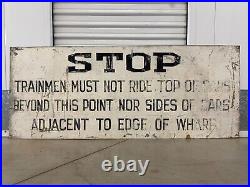
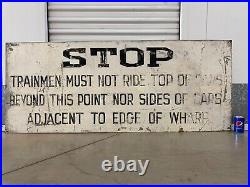
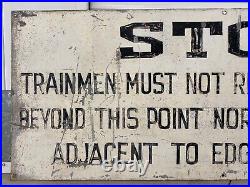
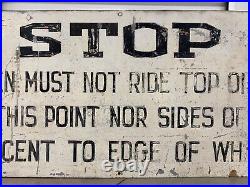
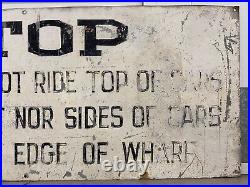
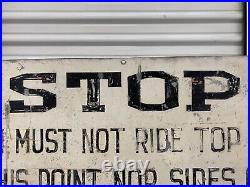
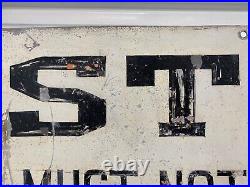
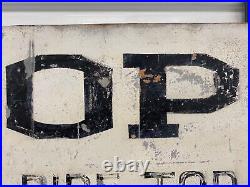
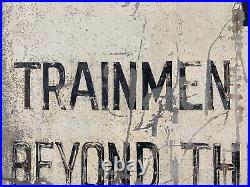
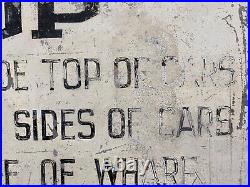
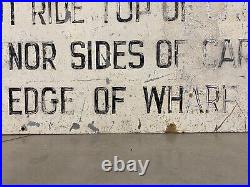
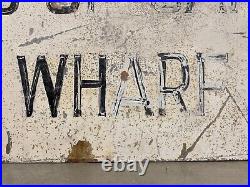
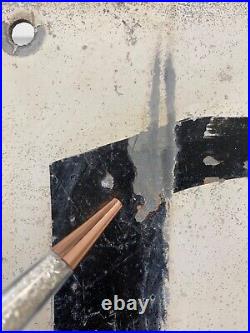
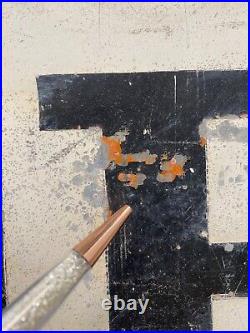
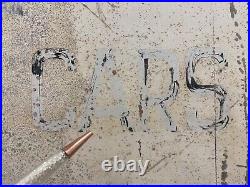
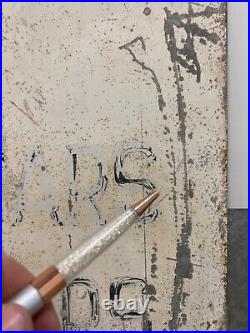
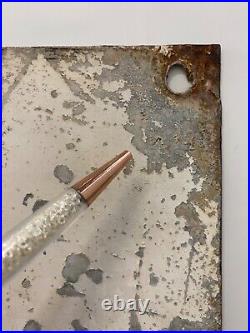

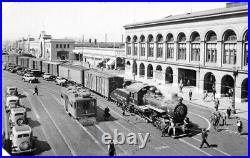
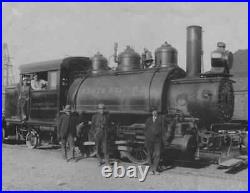
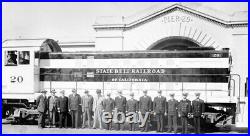
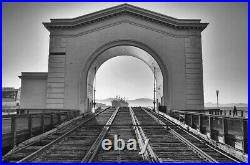

This is a historically significant, original and RARE Antique Old California San Francisco STATE BELT RAILROAD Train Sign, hand painted, likely dating to the 1940’s – 1950’s, which relayed a safety message to trainmen who worked on San Francisco’s short-lived and influential State Belt Railroad line 1890 – 1993. This sign is painted white, with black hand-painted lettering, which reads: STOP. Trainmen must not ride top of cars beyond this point nor sides of cars adjacent to edge of Wharf. The wharf that this sign references is the famed Fisherman’s Wharf of San Francisco, which was utilized by a train ferry slip at the historic Pier 43, which allowed interchange with the Northwestern Pacific, the Western Pacific, the Atchison and Topeka & Santa Fe railroads. To reach its northern terminus in Presidio, the State Belt Railroad line passed through Fisherman’s Wharf, Aquatic Park, and Fort Mason Tunnel. This piece is approximately 24 x 60 inches. Due to the large size and weight of this item, S&H costs will be unavoidably high. Good condition for decades of age and outdoor usage, with expected paint loss, scratches, scuffs, and edge wear please see photos. Acquired from a family collection in Los Angeles, California, who brought this sign back from the Bay Area many decades ago. If you like what you see, I encourage you to make an Offer. Please check out my other listings for more wonderful and unique artworks! About San Francisco’s State Belt Railroad. A Railroad to Improve San Francisco’s Port. The California Gold Rush of 1849 dramatically transformed San Francisco into a bustling port town, exploding with new people and construction. Due to the lack of any proper city planning, San Francisco’s waterfront grew haphazardly into a maze of wharves, piers and warehouses. The state of California established a harbor commission to improve the waterfront’s transportation systems. In 1890, the harbor commission built the State Belt Railroad, designed to improve the flow of goods and materials up and down the waterfront by serving the piers and linking them with the outlying commercial warehouses and railroads. By 1917, the state extended the railroad out to the Presidio army base. At the height of the State Belt Railroad, 67 miles of track were in service. By 1993 the railroad company had gone out of business and the much of the tracks abandoned. When did the State of California take the State Belt Railroad out of service and why? Army deactivated Fort Mason in 1966 and the State of California took the Belt Line Railroad out of service shortly after the completion of the new Letterman General Hospital in 1968. What measures did the City of San Francisco and the National Park Service take to preserve and record the history of the State Belt Railroad during the 2012 Marina Boulevard accessibility improvement work? In 2012, the San Francisco Department of Public Works (SFDPW) made accessibility improvements along Marina Boulevard, replacing 13 curb ramps and three crosswalks to comply with the requirements of the Americans with Disabilities Act (ADA). This work required removal of tracks that lay beneath the pavement in those areas. In coordination with the National Park Service (NPS), the City undertook extensive efforts to document and record the history of the State Belt Railroad, including conducting archival research for the Belt Line and the extension. A standard methodology was adopted for excavation, documentation, data collection, and removal for each project intersection or section of crosswalk. Consultants compiled the research and findings into a report titled Archaeological Investigation Report for the Marina Boulevard Track Removal Project. SFDPW also coordinated with NPS on producing an interpretive element about the State Belt Railroad. By the 1990s the port was moribund, and the Belt Railroad was discontinued. The main tracks of the line have been replaced by a new waterfront streetcar line, though remnants of the Belt line trackage may be seen on many of the piers between the Ferry Building and Pier 45. The Belt line’s roundhouse still stands along the Embarcadero near Pier 27. The Port’s Railroad Has the Best Connections (1953). Owned State Belt Railroad. The Belt Railroad is a terminal switching railroad, meaning that it makes connections only. It does not perform any service other than switching service. Its equipment consists of six 1000-horsepower Diesels. The entire system of trackage is operated as a single yard. The equipment and crews do not go beyond the tracks owned or operated by the Belt Railroad. They provide necessary connection with the four line. Haul carriers serving San Francisco. The Southern Pacific Company has a direct connection with the Belt Railroad. The Atchison, Topeka and Santa Fe Railway Company, the Western Pacific Railroad Company and the Northwestern Pacific Railroad Company interchange with the [Belt rail]road via car ferry barges. Cars are interchanged directly with Southern Pacific at least nine times per day and more frequently if necessary. Cars are interchanged with Northwestern Pacific five times a day, the Santa Fe at least six times a day, the Western Pacific four times and day and oftener when necessary. Ordinarily the State Belt does not hold loaded cars on its tracks, but has a limited amount of siding available for such holding if necessary. The distribution of empty cars to facilities on the State Belt is controlled by the trunk line carriers furnishing the equipment. A limited accumulation of empties is occasionally allowed in the yards when a particularly heavy demand for empties occurs. The State Belt Railroad levies charges on a per car basis regardless of the length of haul. Demurrage accruing on cars moving on the system is collected by the line haul carrier controlling the equipment. The only exception is the so. Called special demurrage provided by the Belt tariff for cars moving entirely from one location on the Belt to another location also on the Belt. Its name is derived from the fact that waterfront property at the time was owned by the State of California, and not the City of San Francisco. When California was originally surveyed, the land along the waterfront was underwater, and thus was not included in San Francisco city limits. The State Belt Railroad saw traffic from both the North Pacific Coast Railroad and the South Pacific Coast Railroad; as both railroads had different gauges, a majority of the State Belt Railroad’s tracks were dual-gauged to accommodate. In addition, interchange with both railroads was done by ferry as the State Belt Railroad had no physical connection with the nation’s rail network; this changed in 1913, when SBRR’s tracks finally joined with Southern Pacific trackage at a small interchange yard. At the height of the State Belt Railroad, 67 miles of track were in its service. 1993 saw the railroad company come to an end, with a majority of tracks already abandoned by this time. Parts of the former main belt line have been rebuilt as the Muni (light rail) Embarcadero line.

